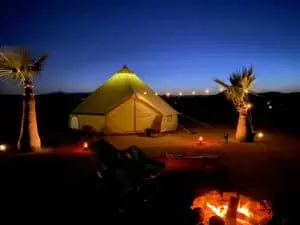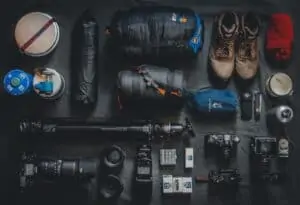How to Choose and Set Up a Camping Tent

In just the past few years, camping is becoming increasingly popular. Studies show that 10.1 million households camped for the first time in 2020. Not only is it an affordable way to vacation but camping is also a great way to reduce stress and improve your mental and physical health.
If you are also feeling the call of the outdoors and want to try out camping, then the first thing you need to get is a camping tent. But it can be difficult to choose the right tent for your needs─ especially if you have never bought one before.
This is why we came up with a comprehensive guide on how to choose and set up a camping tent. Read on for the best camping tent tips.
Floor Space
The first thing you should consider when shopping for a camping tent is how big or small it should be. There are some of the questions you can ask yourself to determine how much space you need such as
- How many people will sleep in the tent?
- Do you have any equipment or luggage to store inside?
- Will you bring along your pets and will they sleep inside the tent?
A good rule of thumb to estimate the size of tent to buy is to allow 20 square feet per person. So, if you will be camping solo, a 20 square foot tent would be enough. If you’re camping with a partner then you need a 40 square foot tent.
Avid backpackers want their tents to be as light as possible so that they can carry them easily while walking. If this is you, you can go for a 15 square foot tent? This won’t leave any space for a second person or if you have many belongings or if you are tall, it will be a tight squeeze. But such a small tent will be lighter and easier to carry around.
Also, note that tentmakers also give general guidelines on how many people can fit into a tent. This is why they label them as one-person, two-person, or four-person tents.
But their guides are often optimistic and refer to small-sized people. If your traveling party has tall adults, a four-person tent may be big enough for only two or three of you.
Consider Floorplans and Tent Design
Look at the floorplans that come with the tent to establish whether your sleeping pads or bags will fit inside. Allow a foot or so at the top and bottom of the pad for occupants to store their items. There should also be a few inches on each side of the pad for elbow room and personal space.
If you’re looking for a tent for several campers, consider getting a tent with two doors. This will make it easier for people to leave on either side without disturbing other occupants in the tent. But a tent with two doors will be heavier and more expensive so you should also think about this when choosing.
In case you have a lot of belongings but don’t want to buy a big tent, consider getting a vestibule. This is an extension that allows you to stake the rain fly out of the camping tent to create a shade. This way you can store your belongings outside the tent floor space but under the vestibule.
Note that the vestibule is a floorless storage space so your belongings will be on the ground. If they are not sealed or zipped, insects and animals may be able to get into them.
Weight
Something else to think about when buying a camping tent is how you will carry or transport it. If you carry the tent on your back while hiking, you need a light tent. The same goes for anyone that will be going kayaking.
If you’re planning to travel to your camp by car, you won’t have to worry about the tent’s weight. Something to note is that the lighter a tent is the less floor space it will have and the more spacious a tent is the heavier it will be.
As you assess a tent’s weight, be aware that most camping tents will display two different weights─ the maximum weight and the minimum weight. The maximum weight includes all the components of a tent such as the poles, tent canopy, rainfly, stakes, guy lines, and stuff sack. The minimum weight consists of everything mentioned above except the stakes, guy lines, and stuff sack.
So, what weight should you go for? If you’re backpacking or kayaking, don’t choose a tent heavier than 4 pounds. You should be able to find a two-person tent at this weight or less. If you’re traveling with your family and going by car, you can pick heavier, more spacious tents.
Height
Camping tents don’t need to have high ceilings because you mainly use them to sleep. Still, height is something you may want to consider when choosing a tent. You want enough space to sit up in the tent without your head touching the top.
You also don’t want to be ducking whenever you move around inside the tent. On the other hand, if the tent is too tall, it becomes unstable, especially in windy weather. Taller tents also use more material so they’re heavier which isn’t ideal for backpackers.
Tentmakers use “peak height” as the measurement of a tent at its highest point. To get an idea of the height of the inside of a tent, subtract 3 inches from the peak height.
A tent of between 35 to 45 inches is ideal for a backpacker. It gives you enough room not to feel claustrophobic. If you’re driving to your campsite, you can choose a taller peak height of about 72 inches.
Season
Do you want to go camping all year round or just over the summer? Your seasons of camping will determine what kind of tent you should buy. If you only intend to camp during the warmer months, you can buy a lightweight 3 season camping tent. This type is good for spring, summer, and fall.
For camping during the winter season too, the best camping tent to buy would be the 4-season tent. These types of camping tents are stronger and heavier and can withstand strong chilly winds as well as snow. They’re more expensive than 3 season tents because they have heavier, more durable materials.
Because winter tents can be extremely warm during the summer, camping enthusiasts often have two tents. A light one for the warm seasons and a heavy one for winter.
Strength and Durability
Campers also must consider how strong they want their tent to be. There is a tradeoff between the strength of a tent and its weight, so backpackers may need to sacrifice strength to have lighter tents.
Tents can also have double-wall or single-wall designs. Double-wall tents have a rain fly on top of the main tent canopy. Single wall tents don’t have a rain fly.
Single wall tents are lighter to carry but they tend to keep in a lot of condensation. If you have a single tent, your body vapor will dampen the walls. So it’s important to buy those with good ventilation.
Choose tents that have air vents, mesh walls, windows, and doors. An advantage of single-wall tents is that they are very light. So hikers and backpackers prefer them.
When it comes to strength, you should also check the material of the tent poles. Most tents have fiberglass or aluminum tent poles. Though fiberglass poles are cheaper, aluminum is lighter and more durable.
This is why we recommend that you get a tent with aluminum poles. You’ll also need to decide whether to use clips of sleeves to attach the tent canopy to the poles. Clips are much easier to set up and they allow air circulation between the double walls of the tent.
The sleeve attachment method is a stronger way to erect a tent, but it’s more complicated and takes a longer time than clips. Many modern tents use a combination of clips and short sleeve attachment to balance the strength of the tent, ventilation in the tent, and ease of setup.
Setting Up a Camping Tent
Once you choose a tent, it’s important to know how to set it up. Below are the key steps you should follow when setting up a camping tent.
1. Protect the Base
The first step you should take when setting up a tent is to create a barrier between the ground and the bottom of your tent. This protects the bottom of your tent from the moisture and dirt of a campground site.
For this step, you can buy a tent groundsheet called a floor guard of footprint. Or you can also use nylon, plastic, or canvas sheets which will serve the same purpose.
Fold the sheet such that its surface area is slightly smaller than the base of your tent. If the tarp is larger than your tent’s base, rainwater will collect underneath your tent and make the floor wet and dirty.
2. Check All the Tent Components
Once you spread out the base, unpack the rest of the tent components. Make sure that you have all the necessary parts.
Modern tents will have the tent canopy, poles, and clips. Older tents may have stakes and cloth coverings.
3. Spread Out the Tent
After confirming that you have everything you need to stand your tent up, you can start setting up your tent. Take the main tent canopy and spread out the base on the ground over the floor guard. Ensure that the doors and windows are facing the direction you want them to.
4. Join Up and Insert the Tent Poles
You now need to connect the tent poles in preparation for the tent. The poles may have ropes connecting them or they may be numbered so that you know which ones to connect. After connecting all the tent poles, lay them flat across the tent.
Follow the manufacturer’s instructions on how to insert the tent poles into the tent. If you have a free-standing tent, you’ll likely have two long tent poles that cross each other to form an ‘x’. This will form the basic frame of the tent.
You may need to slide the tent through a sleeve at the top of the tent. Also, try attaching the pole to plastic clips at the top of the tent.
5. Raise the Tent
Once you insert the tent poles, you can raise the tent into a structure you can sleep in. If you have a large tent, you may need to ask someone else to help you raise the tent.
For small tents, the poles may bend by themselves once you fit them into their right spots. If they don’t, make sure that the tent poles are untangled.
You can then pull the tent corners apart and make sure that the base is square. This should coax the tent to rise. Once the tent is raised, secure any extra hooks or ties that will help the tent stay up.
6. Nail the Tent Down
Now that the tent is up, you need to secure it to the ground. Lay the tent’s base properly on top of the floor guard or tarp. You can then take four metal stakes and put them through the flaps at the bottom corners of your tent.
Push the stakes into the ground to secure the tent. If the ground is hard or rocky, you can use a hammer or blunt object to knock the stakes into the ground. You must be gentle though since some stakes easily bend.
7. Cover the Tent With The Rain Fly
If your tent has a rain guard, the last step would be to install it. Some rain flies have their own tent poles so follow the manufacturer’s instructions on how to install yours.
Learn How to Choose and Set Up a Camping Tent
Choosing a camping tent is a personal choice that is affected by your preferences. You also need to consider camping activities and the number of people you’ll be camping with.
Our camping tent guide has highlighted everything you need to know to choose the right tent for your next camping trip. If you’re looking to get prepared for your next outdoor adventure, check out our camping articles to learn everything you need.
And always remember to be aware of the dangers when sleeping in a tent and fully prepare yourself for any situation that may arise.






